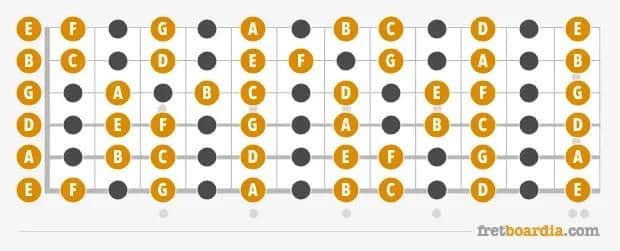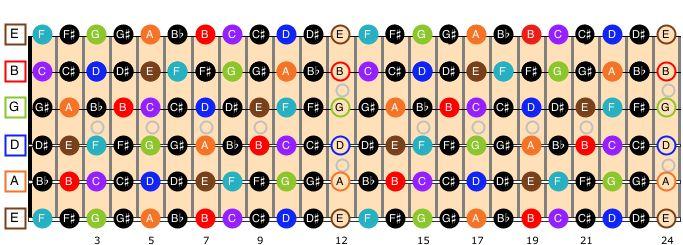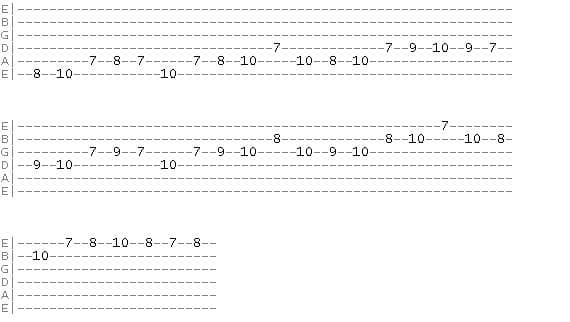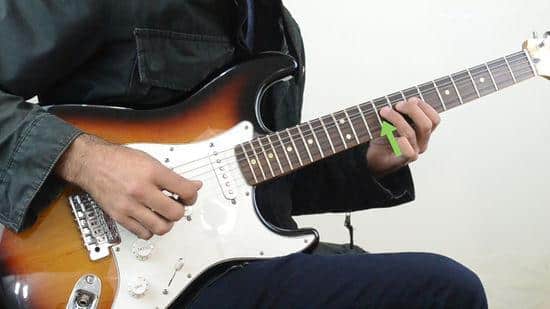Are you ready to unlock a world of emotion through your guitar playing? There was a moment early in my career where I stumbled upon the profound impact of the C minor pentatonic scale on the guitar. This wasn’t just another scale among the many others; its raw power and hypnotic lure opened doors to entirely new musical landscapes. But let me not get ahead of myself, I’ll share that transformative experience shortly.
As a seasoned guitar writer and teacher, I’ve grown to deeply appreciate the beauty and expressiveness embedded within the C minor pentatonic scale. This journey of discovery and transformation, filled with highs, lows, and nearly every emotion between, hasn’t just shaped my music. It’s shaped me. And today, I’m thrilled to embark on this exploration with you.
Whether you’re a budding bedroom guitarist or a seasoned pro seeking fresh inspiration, this complete guide to mastering the C minor pentatonic scale on the guitar promises to take your playing to new sonic heights.
Understanding the C Minor Pentatonic Scale
Components of the Scale

Having grasped the concept of the C minor pentatonic scale, it’s time we delve into its DNA – the components that build the scale, crucial for your journey towards musical mastery. Drawing from my years of experience as an author of instructional books, I have learned to distill the complex into the comprehensible for musicians like you.
The C minor pentatonic scale notes are C, Eb, F, G, Bb. This collection of five notes creates a moody and expressive sound, adored in blues, rock, and jazz. The keyword here is ‘pentatonic’, derived from ‘penta-‘ meaning ‘five’ – a nod to the number of notes in the scale.
Understanding the C minor pentatonic scale formula is essential. It follows a distinct pattern – the 1st (tonic), minor 3rd, 4th, 5th, and minor 7th degrees of the natural minor scale. Recognizing this formula helps internalize the scale’s structure and enables fluid navigation across the fretboard.
Mastering the components of the scale not only enriches your theoretical knowledge but enhances your practical usage of the C minor pentatonic scale. As you progress through this guide, you’ll understand how these components come alive while playing the scale on your guitar.
Indeed, the beauty of music theory lies in its practicality! Let’s embark on this incredible journey of making your fingers speak the rich language of the C minor pentatonic on your guitar strings. Stay tuned as we dissect the scale diagrams in the following section.
Scale Diagrams

In my years of transcribing for various high-profile guitar publications, I’ve noted the critical role that C minor pentatonic scale diagrams play in the learning process. Speaking from personal experience, these diagrams are far from random drawings; they embody the very structure of the scale and provide a visual roadmap for your fingers on the fretboard.
Let me put it this way: the difference between learning a scale formula – the sequence of intervals that make up a scale – and actually interpreting it on your guitar, is significantly bridged by a carefully constructed scale diagram. These diagrams readily translate the theoretical knowledge of the C minor pentatonic scale into a practical, easy-to-follow guide for your fingertips.
Consider the scale diagram as a bird’s-eye view of your guitar neck. This perspective allows you to clearly see the layout of the scale across the entire fretboard, making it easier to navigate the fingerings, locate root notes, and locate different positions of the scale.
Once we’ve grasped the theory, next up is the real action – playing the C minor pentatonic scale on the guitar. Not only will we focus on the different positions and tabs but also step you through some practical exercises to help imprint this vital scale into your muscle memory and refine your technique.
Playing the C Minor Pentatonic Scale on Guitar
Positions and Tabs

Mastering the C minor pentatonic scale on guitar is not just about understanding the theory, but also about knowing the positions and the guitar tabs for C minor pentatonic. Each position, each tab I share embodies my years of guitar playing and the passion for exploring its endless capabilities.
Knowing your way around different positions unlocks the fretboard and allows you to express your musical thoughts freely. For example, the first position of the C minor pentatonic starts on the 8th fret, using this position allows for simple and fluid transitions up and down the scale. The second position begins on the 11th fret, and although it might seem like a stretch, it offers a higher range for melodic possibilities.
Next comes the guitar tablature, or tabs, the visual representation of the strings and frets of the guitar fretboard. Each line represents a string, and the numbers denote which fret to play. Tabs are essential learning tools pointing towards finger placement and technique. They are the roadmap to replicating the sounds we hear and, coupled with scale positions, bring us closer to the nuanced language of guitar improvisation.
Diving into the tabs for the C minor pentatonic scale, you might notice some recurring patterns. These patterns are not coincidences but reflect the repeating structure of the pentatonic scale across the fretboard. The beautiful part of recognizing these patterns is that they unify your understanding and technique, bringing together theory and practice.
In essence, understanding the positions and tabs for the C minor pentatonic scale equips you to express a fuller range of musical ideas. With effective practice, you will create an invisible bond between your fingers and the fretboard, allowing for more authentic, musical expression. We’ll use these insights in our next section where we discuss some practical exercises for mastering the C Minor pentatonic scale. Bear in mind, each tab and position I share is the distilled knowledge of my varied guitar experience, a testament to the beauty of continuous exploration.
Practical Exercises

After grasping the theory and learning to locate the C minor pentatonic scale on your guitar, the next essential step is practical immersion. Practical exercises are vital in engraining the pentatonic scale patterns into your muscle memory, and fostering technique and fluency. These exercises amplify your comfort level while practicing the C minor pentatonic on guitar.
The exercises I’ve shared here are honed over years of teaching guitar students at very different levels. My goal is to make learning this scale a rewarding experience for you. Playing it clean, at a comfortable tempo, ensures you internalise the pentatonic scale without unnecessary tension in your hands. Start slowly, focusing on precision over speed; gradually speed up as you grow more comfortable.
A simple, effective exercise is playing the scale up and down, focusing on alternate picking. Play the ascending scale using downstrokes, and then descending with upstrokes. Also key to remember for a pentatonic scale guitar beginner are the popular ‘1-2-3’ and ‘1-2-3-4’ finger exercises that help train your dexterity and flexibility. Practicing them consistently will dramatically increase the speed and fluidity of your movements.
Furthermore, break the scale down into smaller chunks, suggestively 2 to 4 notes, and practice them in repetition; this helps in mastering those difficult transitions between positions.
Remember the golden rule: Quality over quantity. It’s preferable to practice for fifteen minutes daily than for two hours once a week. An optimal routine for any serious guitarist should be integrating these exercises into daily practice. Indeed, regular practice will reflect in your playing prowess, making the C minor pentatonic scale feel as natural as strumming a chord. So keep practicing with focus and diligence, and soon you’ll find your fingers dancing on the fretboard.
Having developed some mastery through practical exercises, it’s now time to explore the fun part of applying the C minor pentatonic scale in real musical situations, namely improvisation and soloing, where your newly-acquired skill will come alive.
Applying the C Minor Pentatonic Scale: Improvisation and Soloing

As I dove into my Master’s degree in Contemporary Improvisation, I was constantly pushing the boundaries of my guitar playing. Among the many insights I’ve gained from countless hours of playing and active listening, one resonated deeply: the power of the C minor pentatonic scale for improvisation and soloing. This essential and versatile scale has proven invaluable in crafting emotionally articulate solos and improvisations, regardless of the genre.
What’s the secret to evocative and impactful guitar solos? It’s applying the C minor pentatonic, a quintessential sound in rock, blues, and jazz, just to name a few.
This versatile tool can add depth, texture, and mood to your spontaneous compositions. However, using it efficiently requires a deep understanding and a keen ear. Over the years, I’ve developed a few tips and techniques that have managed to boost both my improvisation with C minor pentatonic and guitar soloing with the same scale.
To start, understanding the sonic palette of the C minor pentatonic scale is crucial. Each of its five notes is unique, each carrying its emotion, tension, and release points. For example, I often use the first (C), third (Eb) and fifth (G) degrees of the scale for strong, stable tonal centers during my solos. The remaining two notes, fourth (F) and seventh (Bb), I reserve for building tension that I resolve by moving to a neighboring stable note.
When we think about soloing, we often focus on the ‘what’, i.e., which notes to play. However, the ‘how’ is just as important. One technique I frequently use is playing with note durations and dynamics. Sometimes, letting a single note from the C minor pentatonic scale ring out for a few measures can create a powerful statement. Or, playing some notes louder or softer can influence the overall contour and emotional flavor of a solo.
Next, don’t underestimate the power of silence. A well-placed pause can break up the predictability and give the listeners something unexpected, something that keeps them on their toes.
Finally, remember that practicing improvisation and soloing is not just about executing scales up and down the fretboard. It’s also about listening and being present in the moment. When you play over a backing track or jam with other musicians, try to respond musically to what you hear. This kind of active listening can help you build more engaging and interactive solos.
To sum up, my journey with the C minor pentatonic scale has truly transformed my approach to improvisation and soloing. By focusing on the inherent characteristics of the scale’s notes, experimenting with dynamics and durations, leaving room for pauses, and engaging in active listening, I managed to unlock my true expressive potential and you will too.
In the next section, we’ll tackle some frequently asked questions about the C minor pentatonic scale, where I’ll further explain some of the complex ideas touched upon here, and provide more techniques for using the scale effectively in the context of improvisation and soloing. So, stay tuned!
FAQs
What is the C Minor Pentatonic Scale on Guitar?
How to Play the C Minor Pentatonic Scale on Guitar?
What are Some Exercises to Master the C Minor Pentatonic Scale on Guitar?
Conclusion
As we close this musical exploration, remember—every aspiring guitar hero was once a novice bewildered by that intricate web of guitar strings. Mastering the C minor pentatonic scale on guitar is about that persistent chipping away at each note until the scale becomes second nature. And once it does, the world is your sound stage!
Are you ready to bring a new level of expressiveness and uniqueness to your guitar playing? The C minor pentatonic scale holds the key to that metamorphosis. Its five-note structure underpins some of the richest melodies and compelling improvisations. By understanding its components, studying the diagrams, and practicing the positions and tabs, you’re equipping yourself with a versatile tool—an endless source of sonic inspiration.
So go ahead, put what you learned today into practice. Let your solos soar, your improvisations impress. Stand on the shoulders of musical giants and make the scale your own. And remember, every great musician thrived on endless curiosity. So keep exploring, keep questioning. Happy playing!